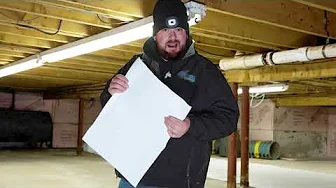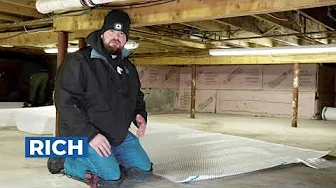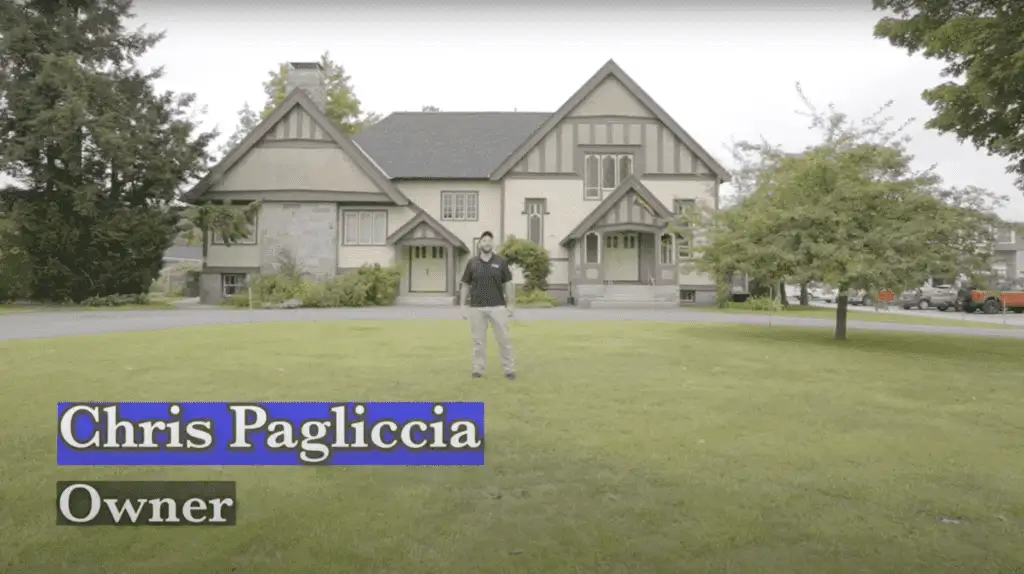Basement Finishing Kittery ME
Transforming your basement from an unfinished area into functional, livable space offers practical and financial benefits. Whether you’re looking to expand your home’s footprint, add value to your property, or create a cozy new retreat, finishing your basement is an efficient way to achieve these goals. Residents of Kittery, ME, can take advantage of this opportunity to maximize their home’s potential.
Real People - Real Great Results
Crawl Space Video Playlist
The Benefits of Basement Finishing
Basement finishing isn’t just about aesthetics; it’s about extracting value from underutilized square footage. It’s a project that pays dividends in multiple ways, whether you’re aiming for practicality, comfort, or a stronger resale game. Here’s how:
- Increase Usable Space: Let’s face it, most basements are glorified storage dumps—damp, cluttered, and a little uninviting. Give that space a purpose. Finished basements morph into family lounges, hobby rooms, or remote work zones. Need extra hands-off space for in-laws or visiting friends? Easy—turn it into a cozy guest suite with its own vibe.
- Improve Home Value: Every square foot matters when it’s time to list your home. In the real estate world, finished basements are gold. Buyers love a fully functional space they don’t have to overhaul themselves. Whether you’re tacking on a home theater or an extra bedroom, you’re not just recouping costs—you’re boosting market appeal.
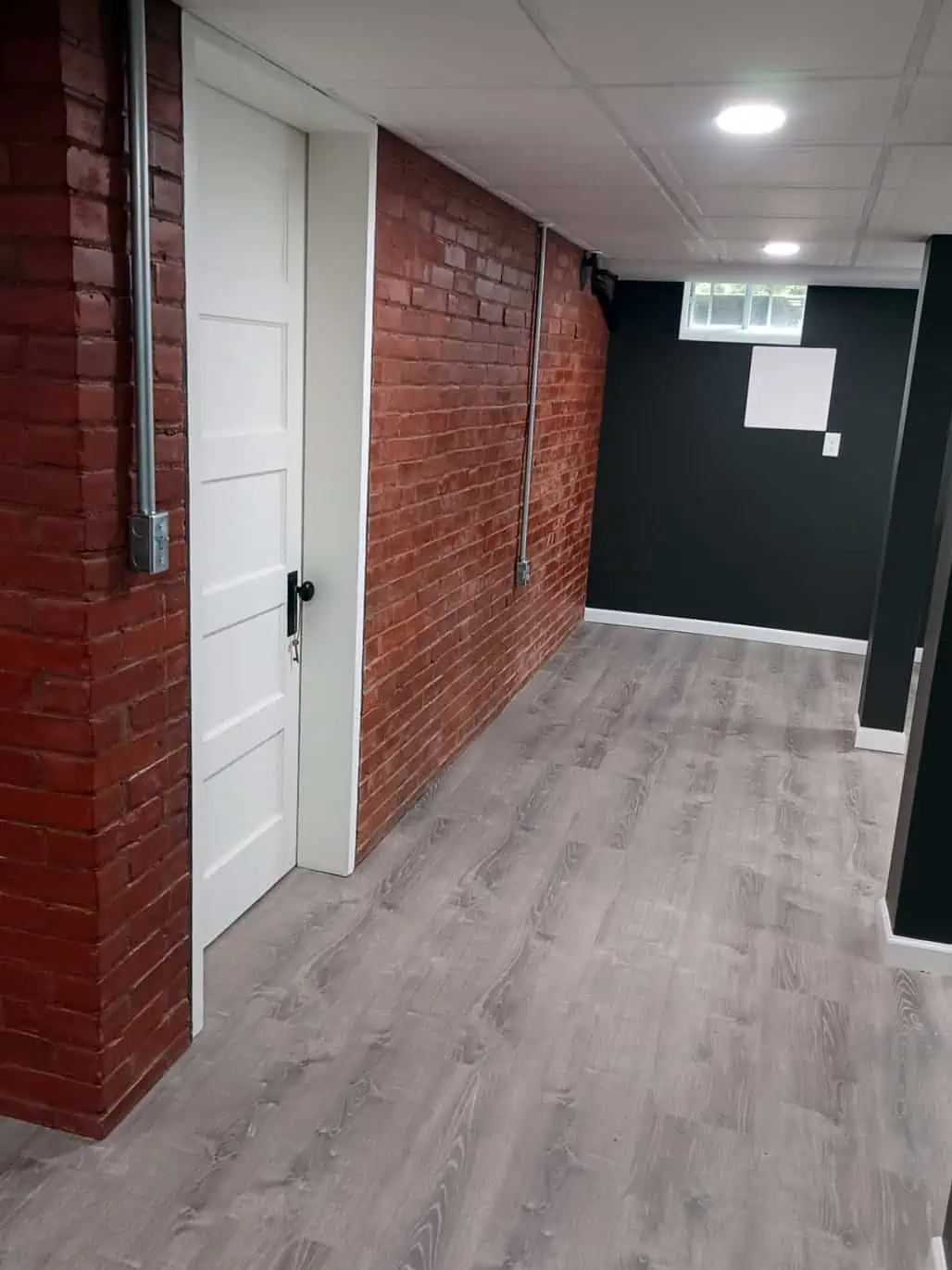
- Boost Energy Efficiency: Tired of watching your heating and cooling bills inflate? A finished basement won’t just look better, it’ll line your wallet in the long run. Insulating walls and sealing drafts during the process shores up your home’s energy use. No more sneaky air leaks chewing through your budget.
- Address Moisture Issues: Basements and moisture tend to go hand-in-hand, but finishing the space forces you to deal with the elephant in the room. Waterproofing, drainage solutions, and vapor barriers are often part of the prep work, leaving you with a space that’s healthier, drier, and far less likely to breed mold or mildew.
Think of finishing your basement as turning dead space into a value-packed resource for your home. Whatever your goal—comfort, utility, or upping your property’s worth—the benefits stack up, making it one of the smartest home upgrades out there.
Key Considerations Before Starting Your Basement Finishing Project
Getting your basement transformation right starts well before the drywall goes up or the flooring gets installed. It’s about laying a solid foundation—figuratively and literally—for a successful project. Here’s where to focus your energy.
- Assess the Structure: Start with the basics: is your basement ready to be finished? Check for signs of trouble like cracks in the foundation, water stains, or a suspiciously persistent musty smell. If you spot any red flags, deal with them now—it’s easier to fix these issues when the walls are still bare. Don’t forget about headroom. Kittery building codes may have specific height requirements, so grab a tape measure. If your space feels a little claustrophobic, you might need to lower the floor or raise the ceiling (and yes, both options can be pricey, but you’ll thank yourself later). Also, give your plumbing and electrical systems a thorough review. Ask yourself: do they need upgrades to support the design you have in mind? An extra bathroom or a full-fledged entertainment setup can tax these systems if they aren’t properly prepped.
- Plan the Layout: It’s tempting to dive in with flashy designs, but pause and think about function first. Are you creating a home office, a cozy family den, or a personal gym? The purpose of the space will dictate everything from wall placement to lighting fixtures. If you’re going ambitious—say, adding a kitchenette or bathroom—plan for utilities like water lines and power outlets early. Changing your mind mid-project isn’t ideal (or cheap). And while you’re at it, weave in some storage options. Closets, built-ins, or even a wall of shelving can go a long way in a space that tends to become the “catch-all” for holiday decorations and old sports gear.
- Understand Local Building Codes: Navigating building codes doesn’t exactly scream fun, but ignoring them could be a costly mistake. Kittery, ME, has its own set of rules dictating things like emergency exits (egress windows), fire safety, and ventilation—rules that aren’t negotiable. Work with someone who knows the local regulations inside and out to avoid surprises. That might mean hiring a qualified contractor who’s done projects in the area. Trust us, the headaches you’ll save by knocking out this step upfront are worth the investment.
- Manage Moisture: Moisture is your basement’s most persistent enemy. No matter how beautiful the finished space looks, water problems can ruin it fast. Install a waterproofing system, like a sump pump or French drains, if your basement has a history of flooding or dampness. Don’t skimp on barriers, either—vapor barriers, good insulation, and sealing materials will help block moisture from sneaking in. Combine these with dehumidifiers to keep the air dry, especially during Kittery’s humid summer months. A dry basement isn’t just a comfortable one; it’s a healthy one.
By tackling these foundational steps, you’re setting yourself (and your basement) up for success. It’s a bit of a grind to tick these boxes, but a well-prepped basement is worth the sweat equity. Once the groundwork is solid, you can shift to the fun stuff—choosing paint swatches and arguing about whether the space really “needs” a minibar.
Materials and Design Tips for a Finished Basement
Flooring
When it comes to basements, flooring isn’t just about aesthetics—it’s about resilience. Stick to materials that can handle the reality of below-ground living, where moisture is always a lurking factor. Luxury vinyl planks or tiles are a popular choice; they mimic the look of hardwood or stone but won’t warp or swell if things get damp. If you prefer something softer underfoot, consider carpet tiles. They’re modular, so if one square gets damaged, you can swap it out without ripping up the whole floor. Sealed concrete is another solid option; it’s durable, low-maintenance, and gives off a no-nonsense vibe. No matter what you choose, adding area rugs is an easy way to warm things up without risking long-term moisture issues.
Walls
Your basement walls need to pull double duty: looking good while keeping the space dry and comfortable. Moisture-resistant drywall is an obvious choice, but wall panels designed specifically for basements can offer an extra layer of protection. They’re quick to install and often come pre-insulated, which is crucial for temperature control. Insulation goes beyond comfort—it’s also about energy savings. Look for rigid foam or spray foam insulation, especially if your walls are concrete or masonry. And don’t skimp on proper sealing; gaps invite drafts and, worse, mold.
Lighting
Basements often get a bad rap for being dark and dungeon-like, but smart lighting choices can flip that script. If you’re lucky enough to have windows, think about installing larger ones or using egress wells to flood the space with daylight (bonus: it can count as an emergency exit, meeting those pesky building codes). For artificial lighting, recessed lights are a staple—they’re sleek, unobtrusive, and provide even coverage. Layer in some wall sconces or track lights to add depth and avoid that washed-out, overly bright look. For task lighting, go with adjustable fixtures that can adapt to whatever you’re doing, whether it’s working from home or tackling a puzzle on game night.
Ceiling
Ceilings in basements are often an afterthought, but they can dramatically affect how the space feels. If you need easy access to plumbing or electrical systems, a drop ceiling with removable tiles is a practical solution. However, these can feel a bit utilitarian, so balance them out with sleek finishes or higher-end tiles. If you prefer an open vibe and don’t mind exposing the guts of your house, paint the ceiling a bright, neutral color—white is a classic choice to make the space feel taller and less confined. Add a few strategically placed light fixtures or pendant lights to draw attention upward and give the ceiling some personality.
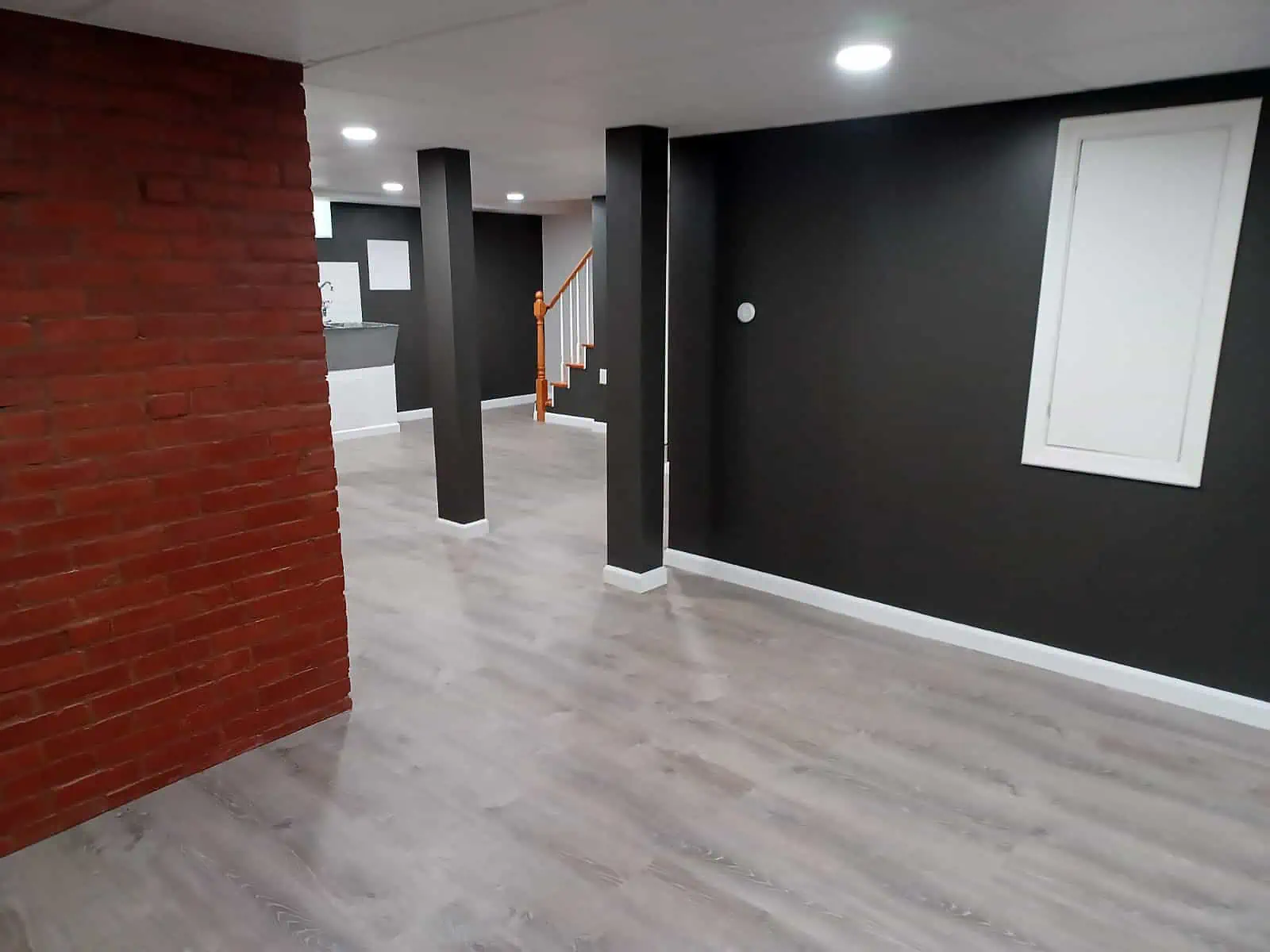
Popular Basement Finishing Ideas in Kittery, ME
Kittery homeowners are opting for basement transformations that make their spaces both practical and personal. Here are a few tried-and-true options to inspire your project:
- Home Office: Working remotely is the new normal, and a basement office offers the perfect blend of focus and seclusion. Forget the distractions of your main living areas—set up a sturdy desk, add a bookshelf or two, and you’ve got yourself a productivity zone. Bonus: soundproofing your walls keeps meetings kid- and pet-noise-free.
- Family Room: What better way to bring everyone under one roof than a cozy family space? Think oversized sectional, a flatscreen mounted on the wall, and a stash of board games. Whether it’s movie marathons, gaming tournaments, or just a quiet spot for reading, a basement family room meets all the needs.
- Fitness Area: Gym memberships? Overrated. Turn your basement into a dedicated fitness hub—yoga mats on one side, free weights on the other, with a treadmill tucked neatly into a corner. Rubberized flooring keeps things impact-friendly, and a wall of mirrors does double-duty for form and making the space feel bigger.
- Guest Suite: If you’ve got friends or family who tend to linger (or if multi-generational living is your reality), a guest setup is a game-changer. Add a bedroom, a small bath, and maybe even a coffee nook. Visitors get privacy; you get to keep your upstairs space traffic-free.
- Storage Solutions: Not every basement has to scream “Pinterest goals.” A finished space can also bring order to your chaos. Think built-in shelving for boxes, seasonal décor, or tools. Add labeled cabinets or drawers for smaller items, and suddenly, that cluttered pile is transformed into an organized dream.
The beauty of basement finishing in Kittery, ME, is customization—your basement doesn’t have to look like anyone else’s. Keep it simple or deck it out; either way, you’re upgrading your home and your lifestyle.
Hiring Professionals vs. DIY
Let’s cut to the chase: basement finishing isn’t your average weekend warrior project. Sure, slapping paint on walls or assembling IKEA furniture is fair game for most homeowners, but transforming an unfinished basement into a polished, code-compliant living space? That’s a different animal. While DIY can save you upfront cash, it often comes with a steep learning curve, hidden costs, and unforeseen headaches. Here’s why working with professionals in Kittery, ME, is often the smarter path.
First, the technical stuff. Proper insulation, ventilation, and moisture control aren’t just optional extras—they’re the backbone of a successful basement transformation. They require experience, precision, and yes, tools that probably aren’t in your garage. A professional contractor ensures that these critical elements are handled correctly, sparing you a future filled with damp walls, cold winters, and energy bills that will make your jaw drop.
Then there’s the matter of building codes. In Maine, and Kittery specifically, basements have to meet strict requirements for things like ceiling height, egress windows, and fire safety. Skip a step or make a wrong move, and you could delay your project—if not fail a crucial inspection. Pro contractors know these codes cold, streamlining the process and giving you peace of mind.

Finally, professionals save you from the landmines of inexperience. A poorly executed DIY job can lead to costly mistakes—imagine wiring that trips your circuit breaker or drywall that warps because the moisture barrier wasn’t installed correctly. Contractors have the skills and foresight to dodge these pitfalls, and they come equipped with warranties or guarantees for the work they perform. DIY? You’re on your own.
Of course, collaboration doesn’t mean you’re out of the picture. A good contractor will listen to your vision, work within your budget, and offer advice on selecting layouts, materials, and finishes. At the end of the day, pros make the process faster, smoother, and built to last—so you can enjoy your newly finished basement without second-guessing every board and bolt.
Maintenance Tips for Your Finished Basement
Once you’ve invested time and money into transforming your basement, keeping it in top condition should be a priority. A little effort in maintenance goes a long way in preventing costly repairs down the line. Here are a few streamlined tips to protect your finished space:
- Inspect for Moisture Annually: Basements and moisture are old acquaintances, even in a well-finished space. Check for water stains, damp spots, or unusual odors at least once a year. If you detect anything suspicious, address it immediately—small leaks often turn into big headaches.
- Ventilation Is Key: A finished basement won’t breathe on its own. Invest in a dehumidifier and run it regularly, especially during Kittery’s humid summers. Make sure HVAC vents, fans, or windows are used to keep the air circulating. Mold prevention is one chore you don’t want to skip.
- Protect Your Floors: Whether you’ve opted for luxury vinyl, tile, or carpet, take measures to keep flooring intact. Use area rugs to stave off wear and tear in high-traffic spots. Place furniture pads under couches, tables, and entertainment centers to avoid scuffs and dents.
Treat your newly finished basement like the valuable extension of your home it has become. Just a few simple habits can keep it feeling fresh, functional, and ready for years of use.
Conclusion
A finished basement isn’t just extra square footage—it’s a game-changer for your home. Whether you’re carving out space for a home office, a family hangout zone, or a guest suite, the benefits are undeniable. You’re not just adding utility; you’re adding value, style, and comfort. In Kittery, ME, where homes range from historic gems to modern builds, the basement is a canvas waiting for the right touch. A smart investment of time and resources can turn that dark, forgotten space into something that works as hard as the rest of your house. Plan it right, stick to the basics, and let your vision drive the project. Live better, below ground.
Reviews from Happy Customers
Our top priority is customer satisfaction, and we work closely with clients to understand their unique needs and goals.




